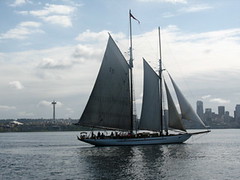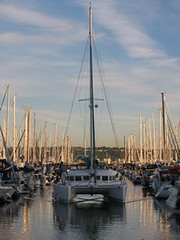There are some choices in life for which there is no correct answer: paper vs. plastic, cloth vs. disposable, tastes great vs. less filling. Then there are others which you simply must avoid in the interest of self-preservation since registering your opinion will bring down the wrath of fundamentalists on both sides of the debate: to vaccinate or not to vaccinate, pro-life or pro-choice, Starbuck’s or Tully’s.
I try to avoid these debates. It’s not that I don’t have strong opinions. In fact, it is probably fair to say that I have strong opinions about virtually any topic you should care to mention. But as I grow older I have begun to recognize my limits, and there are hills I just do not care to die on. Unfortunately, along with my new cruising life my husband accidentally thrust us into one of the most vigorous verbal battles of our generation: mono-hull versus multi-hull.
The two camps break down roughly as follows. In the right corner, we have rich and fascinating 500 year history of western European mono-hull sailing. There are literally berzillions of words written on the topic and entire regions of the world devoted to the successful production and maintenance of these vessels. The modern cruising community as we know it started with mono-hulls, and these single-keeled craft still dominate the cruising landscape. Certainly, most of the major authors writing in the trade magazines, publishing their work and delivering seminars at boat shows, began in a mono-hull and remain convinced of their superiority. This camp is championed by a handsome white man, about 50, distinguished, knowledgeable, stylishly dressed for dinner at a seaside restaurant.
In the left corner, we have an eclectic, pan-Pacific 3,000 year history of multi-hull crafts reaching from tiny Polynesian trading trimarans to the stunning, blade sharp 180 foot long hulls of modern racing catamarans. Catamarans enjoy increasing popularity in the charter trade as folks discover how many more relatives you can fit on a 50’ boat with six bedrooms and four heads. As a result production manufacturers appeared on the scene about a decade ago pumping out two-hulled, house boats with a profligacy resembling a rabbit breeding program. This camp is represented by a guy in his early 30’s of indeterminate Heinz-57 varieties ethnicity who casually tossed on a pair of Crocs, Bermuda shorts, and a loose tropical shirt.
Ding ding ding! Round 1 – Safety
Monohull Man: Catamarans break anchor and run aground.
Catamaran Guy: Snort. Everything breaks anchor some day. But when your boat does it, the thing hits shore and flops over like a dead fish. With my boat, we call it beaching and do it on purpose.
Monohull Man: Yes, but your two hulled wonder flips over and stays that way.
Catamaran Guy: Yeah, but your leaner sinks when you put a hole in the hull.
Monohull Man: Ha! Your boat can’t handle the stress of heavy winds!
Catamaran Guy: Fine! But your boat is so deep keeled you can’t get into half as many protected anchorages.
Judgement – I’m going to call this one a draw. Any boat is dangerous in the wrong hands. Any decently well-founded boat is safe if not taken into conditions it can’t handle. Know your boat, watch the weather, and make your decisions based on the conditions rather than the calendar.
Ding Ding Ding! Round 2 – Cost
Monohull Man: Cost per square foot on a catamaran is higher.
Catamaran Guy: What do you want? Two hulls for the price of one? Yeah, sure, it’s a bit pricier, but you can bring the entire gang, invite all your friends, share the cost.
Monohull Man: Two engines, two electrical systems, two hulls to paint. Need I say more?
Catamaran Guy: Yeah, how about you sing the Safety Dance? Re-dun-dan-cy, babe. You keep harping about safety… how about the safety of having two engines?
Monohull Man: Dock space for those enormous floating turtles is hard to find and more expensive.
Catamaran Guy: Dude, there you are flat out smoking crack. You pay by the foot at most guest docks, and my boat’s a good fifteen feet shorter than yours. You want to park that long tube in a marina for months, your problem. You want to anchor out, ride the non-existent waves of my boat.
Judgement – Round 2 to Monohull Man. No question cats are more expensive in dozens of different ways. It takes a well-heeled dreamer to afford the space and comfort. It’s also true, though, that there ways to reduce the cost of cat ownership including anchoring out more and in greater comfort even in choppy weather.
Ding Ding Ding! Round 3 – Comfort
Catamaran Guy: We aren’t really going to have this conversation, are we?
Monohull Man: Well…um… no.
Judgement – Round 3 to Catamaran Guy. Only the most hardened and fanatic monohull manic will tell you the single hull life life is more comfortable. They’ll try to spin a yarn about rocking horse motion and booming against the bridge deck. It’s sour grapes.
Ding Ding Ding! Final Round – Performance
Monohull Man: Can we skip this one too?
Catamaran Guy: Yeah.
Judgement – Final round goes to neither actually. While sailors agree in principle that cats should be faster than monohulls, the truth is neither category takes the prize here. Our lovely Lagoon is a complete lazy bag and couldn’t win a race if her very existence depended on it. She truly is a floating house. On the other hand, catamarans are handily winning major races around the world with their longer water lines and lean lines. Performance is about a specific design not about whether there is one hull or two. You’d be hard pressed, however, to find a trimaran that doesn’t blow past all the competition at faster than wind speed.
* * *
So who wins this War of the Roses? Those who buy a boat and go.
I try to avoid these debates. It’s not that I don’t have strong opinions. In fact, it is probably fair to say that I have strong opinions about virtually any topic you should care to mention. But as I grow older I have begun to recognize my limits, and there are hills I just do not care to die on. Unfortunately, along with my new cruising life my husband accidentally thrust us into one of the most vigorous verbal battles of our generation: mono-hull versus multi-hull.
The two camps break down roughly as follows. In the right corner, we have rich and fascinating 500 year history of western European mono-hull sailing. There are literally berzillions of words written on the topic and entire regions of the world devoted to the successful production and maintenance of these vessels. The modern cruising community as we know it started with mono-hulls, and these single-keeled craft still dominate the cruising landscape. Certainly, most of the major authors writing in the trade magazines, publishing their work and delivering seminars at boat shows, began in a mono-hull and remain convinced of their superiority. This camp is championed by a handsome white man, about 50, distinguished, knowledgeable, stylishly dressed for dinner at a seaside restaurant.
In the left corner, we have an eclectic, pan-Pacific 3,000 year history of multi-hull crafts reaching from tiny Polynesian trading trimarans to the stunning, blade sharp 180 foot long hulls of modern racing catamarans. Catamarans enjoy increasing popularity in the charter trade as folks discover how many more relatives you can fit on a 50’ boat with six bedrooms and four heads. As a result production manufacturers appeared on the scene about a decade ago pumping out two-hulled, house boats with a profligacy resembling a rabbit breeding program. This camp is represented by a guy in his early 30’s of indeterminate Heinz-57 varieties ethnicity who casually tossed on a pair of Crocs, Bermuda shorts, and a loose tropical shirt.
Ding ding ding! Round 1 – Safety
Monohull Man: Catamarans break anchor and run aground.
Catamaran Guy: Snort. Everything breaks anchor some day. But when your boat does it, the thing hits shore and flops over like a dead fish. With my boat, we call it beaching and do it on purpose.
Monohull Man: Yes, but your two hulled wonder flips over and stays that way.
Catamaran Guy: Yeah, but your leaner sinks when you put a hole in the hull.
Monohull Man: Ha! Your boat can’t handle the stress of heavy winds!
Catamaran Guy: Fine! But your boat is so deep keeled you can’t get into half as many protected anchorages.
Judgement – I’m going to call this one a draw. Any boat is dangerous in the wrong hands. Any decently well-founded boat is safe if not taken into conditions it can’t handle. Know your boat, watch the weather, and make your decisions based on the conditions rather than the calendar.
Ding Ding Ding! Round 2 – Cost
Monohull Man: Cost per square foot on a catamaran is higher.
Catamaran Guy: What do you want? Two hulls for the price of one? Yeah, sure, it’s a bit pricier, but you can bring the entire gang, invite all your friends, share the cost.
Monohull Man: Two engines, two electrical systems, two hulls to paint. Need I say more?
Catamaran Guy: Yeah, how about you sing the Safety Dance? Re-dun-dan-cy, babe. You keep harping about safety… how about the safety of having two engines?
Monohull Man: Dock space for those enormous floating turtles is hard to find and more expensive.
Catamaran Guy: Dude, there you are flat out smoking crack. You pay by the foot at most guest docks, and my boat’s a good fifteen feet shorter than yours. You want to park that long tube in a marina for months, your problem. You want to anchor out, ride the non-existent waves of my boat.
Judgement – Round 2 to Monohull Man. No question cats are more expensive in dozens of different ways. It takes a well-heeled dreamer to afford the space and comfort. It’s also true, though, that there ways to reduce the cost of cat ownership including anchoring out more and in greater comfort even in choppy weather.
Ding Ding Ding! Round 3 – Comfort
Catamaran Guy: We aren’t really going to have this conversation, are we?
Monohull Man: Well…um… no.
Judgement – Round 3 to Catamaran Guy. Only the most hardened and fanatic monohull manic will tell you the single hull life life is more comfortable. They’ll try to spin a yarn about rocking horse motion and booming against the bridge deck. It’s sour grapes.
Ding Ding Ding! Final Round – Performance
Monohull Man: Can we skip this one too?
Catamaran Guy: Yeah.
Judgement – Final round goes to neither actually. While sailors agree in principle that cats should be faster than monohulls, the truth is neither category takes the prize here. Our lovely Lagoon is a complete lazy bag and couldn’t win a race if her very existence depended on it. She truly is a floating house. On the other hand, catamarans are handily winning major races around the world with their longer water lines and lean lines. Performance is about a specific design not about whether there is one hull or two. You’d be hard pressed, however, to find a trimaran that doesn’t blow past all the competition at faster than wind speed.
* * *
So who wins this War of the Roses? Those who buy a boat and go.

